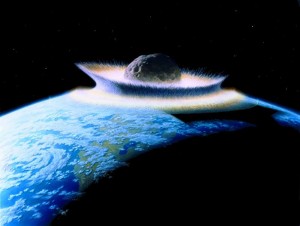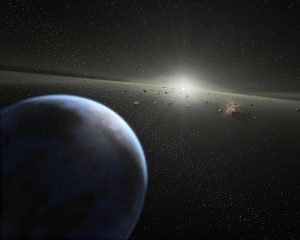19 December 2014
Computer models simulate asteroid impacts
Posted by kwheeling
By Lisa Potter

Souheil Ezzedine and colleagues simulated several scenarios to support FEMA’s efforts to increase their emergency preparedness in the event of an asteroid impact.
Credit: Don Davis
An asteroid impact 100 miles (170 kilometers) off the coast of Maryland would send waves up to 50 feet (15 meters) high onto the shore an hour later and massive flooding would occur three hours after impact, according to a new computer simulation of hypothetical asteroid impacts. The model is the first of its kind and federal agencies have used it to assess potential hazards arising from such impacts in an effort to increase U.S. emergency preparedness, planning and management, the scientists say.
Earth orbits through space alongside a swarm of debris, called near earth objects (NEO), which are difficult to detect because they reflect little sunlight. Despite decades of searching, scientists have detected few NEOs smaller than about .6 miles (1 kilometer) across. This is troubling considering an asteroid about 150 feet (50 meters) across could destroy a large city, said Souheil Ezzedine, an applied mathematician and statistician at the Lawrence Livermore National Laboratory in Livermore, California, at a poster session on Tuesday at the American Geophysical Union’s Fall Meeting.
Ezzedine and his colleagues have simulated asteroid ocean-impact scenarios to support emergency preparedness planning by federal agencies. At his poster, Ezzedine presented his team’s analysis when an asteroid struck 100 miles (~170 kilometers) off the coast of Maryland. The researchers developed the simulation for several federal agencies to use to improve emergency preparedness at the Federal Emergency Management Agency headquarters in Washington D.C. in 2013.
When an asteroid smacks the ocean, the magnitude of the resulting wave depends on two things: the depth of the water and the size of the asteroid.

A massive asteroid belt orbits our sun between Mars and Jupiter. Asteroids can enter into the inner solar system and impact Earth.
Credit: NASA/JPL-Caltech
“If the water is deep and the size of the asteroid is small, it’s like a rock in a swimming pool,” said Ezzedine. In this case, the wave emanating from the “source,” or the point of impact, will be small ripples.
However, if a big asteroid hits shallower water, the waves will be much more severe. The researchers modeled the process by which the asteroid surges toward the water and — SMACK — hits the surface. The impact forces water out and up, forming the initial wave, or tsunami, which flows out in all directions.
Once the researchers modeled where the surge flooded the coast, they overlaid data including daytime population, hospitals, transportation and more. This allowed the scientists to see how water inundated the land one and three hours after impact and what important facilities would be affected.
Wave height varied up the coast, but in extreme cases, the models predicted that one hour after impact, waves would reach heights between 30 and 50 feet (nine and 15 meters). Three hours after impact, the southern tip of the Delmarva Peninsula was flooded and inland inundation occurred from the Atlantic and Chesapeake Bay. This information could allow the Federal Emergency Management Agency to prioritize evacuations and their resources, the scientists say.
“These models allow us to see whether we’re prepared or not. Once a wave is modeled, it can be caused by anything, like an earthquake,” said Ezzedine. “The technology can be transferred to other areas of high risk.”
Lisa Potter is a science communication graduate student at UC Santa Cruz.










 GeoSpace is a blog on Earth and space science, managed by AGU’s Public Information staff. The blog features posts by AGU writers and guest contributors on all sorts of relevant science topics, but with a focus on new research and geo and space sciences-related stories that are currently in the news.
GeoSpace is a blog on Earth and space science, managed by AGU’s Public Information staff. The blog features posts by AGU writers and guest contributors on all sorts of relevant science topics, but with a focus on new research and geo and space sciences-related stories that are currently in the news.